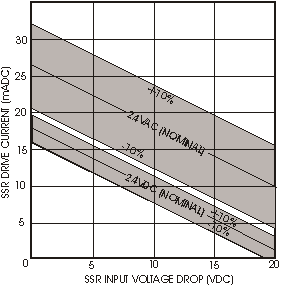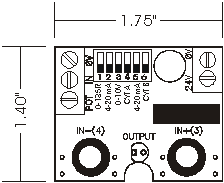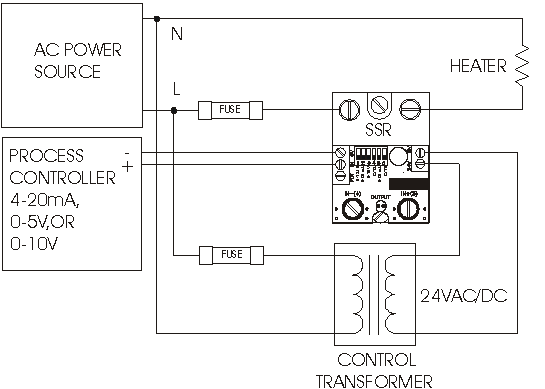Zero Cross SCR Power Controller Users Manual (Burst Fire)
SSR Intelligent Power Control Module
-
Ordering Code
-
Description
-
Features
-
Installation
-
Mounting Instructions
-
Electrical Connections
-
Operation
-
Power
-
24V Power Fusing
-
Command Input
-
Input Fail-Safe Protection
-
Cycle Times
-
Power Limit
-
Power Limit Adjustment Procedure
-
Configuration Dipswitch
-
Control Output
-
Output LED
-
Three Phase Operation
-
Three Phase Operation - Cycle Times
-
Wiring Multiple Units
-
Connecting Power & Commands in Parallel
-
Electrical Specifications
-
Mechanical Dimensions
-
Contact Information
-
Wiring Diagram (4-20mA, 0-5V, 0-10V Inputs)
-
Wiring Diagram (Potentiometer Input)
-
Wiring Diagram (0-135Ω Input)
-
Wiring Diagram (3 Phase Delta)
-
Wiring Diagram (3 Phase Wye)

1 Ordering Code
Zero Cross SSR
Controller Assembly P/N
Description
Inputs
APCSCR1Z
APCSCR1Z-135
APCSCR1Z-REV
APCSCR1Z-PL
SSR Mount Burst Firing Control Module, 0-135Ω Input, 24VAC Power Only
Reverse Acting Output Option
SSR Mount Burst Firing Control Module with Power Limit Option, 24VAC Power Only
2 Description
The APCSCR1Z is a burst firing control module designed for use with standard footprint zero cross or random fire SSRs (Solid State Relays). The module mounts directly on the SSR's input screws. The module operates by varying duty cycle of SSR's control input. The power delivered to the load is proportional to the command input signal.
2.1 Features
-
Command input accepts 4-20mA, 0-10V, 0-5V, 0-135Ω, Potentiometer
-
Configurable for 4 different cycle times
-
Drives multiple solid state relays (SSRs)
-
Small (1.75" x 1.40") module mounts on the input terminals of an inexpensive SSR
-
Fits under touch-safe covers
-
LED output indicator
-
Adjustable Power Limit (-PL) Option
-
Single phase and three phase control
3 Installation

WARNING: FIRE HAZARD!! Even quality electronic components CAN FAIL KEEPING FULL POWER ON! Provide a SEPARATE (redundant) OVER TEMPERATURE SHUTDOWN DEVICE to switch the power off if safe temperatures are exceeded.

WARNING: HIGH VOLTAGE!! This control is installed on a Solid State Relay with high voltage on it. This control must be installed in a GROUNDED enclosure by a qualified electrician in accordance with applicable local and national codes including NEC and other applicable codes. Provide a safety interlock on the door to remove power before gaining access to the device.
3.1 Mounting Instructions
The APCSCR1Z mounts directly to the control input terminals an SSR. Some relays have short input screws and longer screws will be required to reach through the contacts on the APCSCR1Z. Be sure to observe the correct polarity when mounting the module (module should be positioned over the SSR). The module should sit firmly on top of the SSR when the screws are tightened.
3.2 Electrical Connections
See the WIRING DIAGRAMS at the end of this document. Make sure the module ordered is the correct module for the application before wiring.
Before wiring the module, all Dip Switch settings for the command input and special features should be setup properly per the Dipswitch Configuration Section.
4 Operation
4.1 Power
The APCSCR1Z power requirement is 24VAC +/-15% 47-63Hz, 24VDC +30%/-10%.
4.2 24V Power Fusing
Fusing may be accomplished by fusing each module separately or fusing groups of modules with either primary or secondary fusing. The current draw of each APCSCR1Z is 65mA max.
4.3 Command Input
The APCSCR1Z can accept 4-20mA, 0-10V, 0-5V, and Potentiometer inputs. The APCSCR1Z-135 can only accept a 0-135Ω Input, and must be used with 24VAC Power. All command inputs are not isolated from the 24V power input, they share a common ground. The type of command input can be configured via the dipswitch. The default setting is 0-5V/potentiometer.
When wiring multiple APCSCR1Z's together, follow the guidelines in the Wiring Multiple APCSCR1Z's section.
Any leg of the command input can tolerate shorts to the (0V) input. Connecting the 24V power to the command input will cause damage to the unit.
4.3.1 Input Fail-Safe Protection
If the signal sent to the APCSCR1Z's command input should become electrically open, the control output will be forced to an off or less than 5% output power state.
4.4 Cycle Times
The APCSCR1Z has 4 available cycle times of 200mS, 1S, 10S, and 100S. Generally, the cycle time should be chosen based on the mass of the load to be controlled; the larger the load mass, the longer the cycle time can be. Generally, it's best to choose the longest cycle time that can be used without causing process ripple.

4.5 Power Limit
The Power Limit option can be ordered as APCSCR1Z-PL. The Power Limit feature is used to limit the average power delivered to the load. The power limit is adjustable via a potentiometer located just below the input terminal block. The Power Limit feature is only available for use with 24VAC Power.
4.5.1 Power Limit Adjustment Procedure
The Power Limit is adjustable from 5% to 100% of the max load power (0-100% for 1-5V or 4-20mA ranges). Setting the Power Limit potentiometer half way corresponds to a power limit of approximately 55%. With the command input set to approximately 100% (on startup) turn the pot fully CCW. Then just turn the pot CW until the desired output power is achieved.
4.6 Configuration Dipswitch
The configuration dipswitch is used for setting up the command input and the cycle time. Using a pen point, gently push the switch up for on and down for off according to the setup outlined in the table below.

COMMAND INPUT
1
2
3
5
0-5V (Default)
Potentiometer
Off
Off
Off
Off
0-10V
4-20mA
1-5V
2-10V
0-135Ω*
*Module must be ordered as APCSCR25/40/50-1P-135 for 0-135Ω input support.
0-135Ω input support is only usable with 24VAC Power.
CYCLE TIME
4
6
200mS
1 Second
Off
Off
10 Seconds
100 Seconds
Off
Off
On
On
On
On
On
Off
Off
Off
Off
Off
On
Off
Off
Off
Off
Off
On
On
Off
Off
Off
Off
On
On
On
Off
Off
Off
4.7 Control Output
The APCSCR1Z SSR output drive is a DC pulsed current limited drive signal of 10V/15mA (24VAC Power) or 10V/9.5mA (24VDC power). This is more than enough current for driving most 3-32V standard SSRs, however it is still important to review the data sheet for the SSR you would like to use for compatibility with the APCSCR1Z's output drive. The control output can tolerate a momentary direct short. The following graph will allow you to verify the SSR's compatibility with the APCSCR1Z over wide input voltage variations.

APCSCR1Z Output Drive Current vs. SSR Input Voltage Drop
4.8 Output LED
The APCSCR1Z's RED output LED will turn on when the output is on. The output LED is wired in series with the SSR's input. If there is a poor connection on the SSR input terminals or a problem with the SSR's input, the output LED will not become energized.
4.9 Three Phase Operation
One APCSCR1Z can be used to control two poles of a three phase load using two SSRs with their control inputs wired in parallel. The Module should be wired as shown in the three phase wiring diagrams sections. The Control Output section should be reviewed to make sure that the total input current requirements of the two SSRs can be achieved with the APCSCR1Z.
4.9.1 Three Phase Operation - Cycle Times
When using the APCSCR1Z to control three phase loads, the cycle time should be set for at least one second and preferably 10 or 100 seconds. This will maximize the control resolution and minimize any load imbalances.
4.10 Wiring Multiple Units
If more than one APCSCR1Z is to be used from a non-isolated or common command signal:
-
A common power transformer can be shared. If the input selected is 0-10V or 0-5V, the inputs should be wired in parallel.
-
If multiple units must be powered from one power transformer and 4-20mA input is selected, one module should be set for 4-20mA and the remaining modules should be set for 1-5V.
-
If the command is 4-20mA, and the command inputs are to be wired in series, a separate power transformer for each module is required to isolate the inputs.
5 Electrical Specifications
Command Inputs
Input Impedance
4-20mA, 0-10V, 0-5V, 0-135Ω, Pot
0-135Ω Excitation Current
10K Ω (0-10V), 250Ω (4-20mA), 100K Ω (0-5V)
Control Output
Output Resolution
Output Linearity
Power Limit Range
13mA max
SSR Drive, nominally 10V@15mA (24VAC), 10V@9.5mA (24VDC)
0.5% for 4-20mA, 0-5V, Pot and 0-10V. 1% for 0-135Ω
1.5% for 4-20mA, 0-5V, Pot and 0-10V. 5% for 0-135Ω
5-100% of max load power
External Potentiometer Res.
Ambient Temperature Range
Power Supply
Power Consumption
10K Ω-25K Ω
0 to 70 °C
24VAC +15/-15%, 24VDC +30%/-10%
Less than 2 Watts
5.1 Connection Power & Commands in Parallel
When multiple APCSCR1Z power inputs and commands are wired in parallel, all of the 0V terminals must be connected together as follows:
Power:
Input Impedance
Command:
0-135Ω Excitation Current
10K Ω (0-10V), 250Ω (4-20mA), 100K Ω (0-5V)
13mA max
No crossing of the power input feed or command signal is permitted. If for some reason the power should become crossed, it will cause a direct short in the system. If properly fused, the fuse will blow and the APCSCR1Z will not be damaged. If the command inputs are wired improperly, damage to APCSCR1Z can result.
We do not guarantee operation of the APCSCR1Z with any other manufacturer's SSR control module. Using them in the same circuit may cause either module to be damaged.
6 Mechanical Dimensions

Max Height is 0.6"
7 Contact Information
Anacon Power & Controls
800-466-9080
www.anaconpower.com
8 Wiring Diagram (4-20mA, 0-5V, 0-10V Inputs)

9 Wiring Diagram (Potentiometer Input)

10 Wiring Diagram (0-135Ω Input)

11 Wiring Diagram (3 Phase Delta)

12 Wiring Diagram (3 Phase Wye)

Address
Anacon Power & Controls
100 Powder Mill Rd. Suite 162
Acton, MA 01720
Phone
TEL: 800-466-9080
TEL: 978-287-0715
